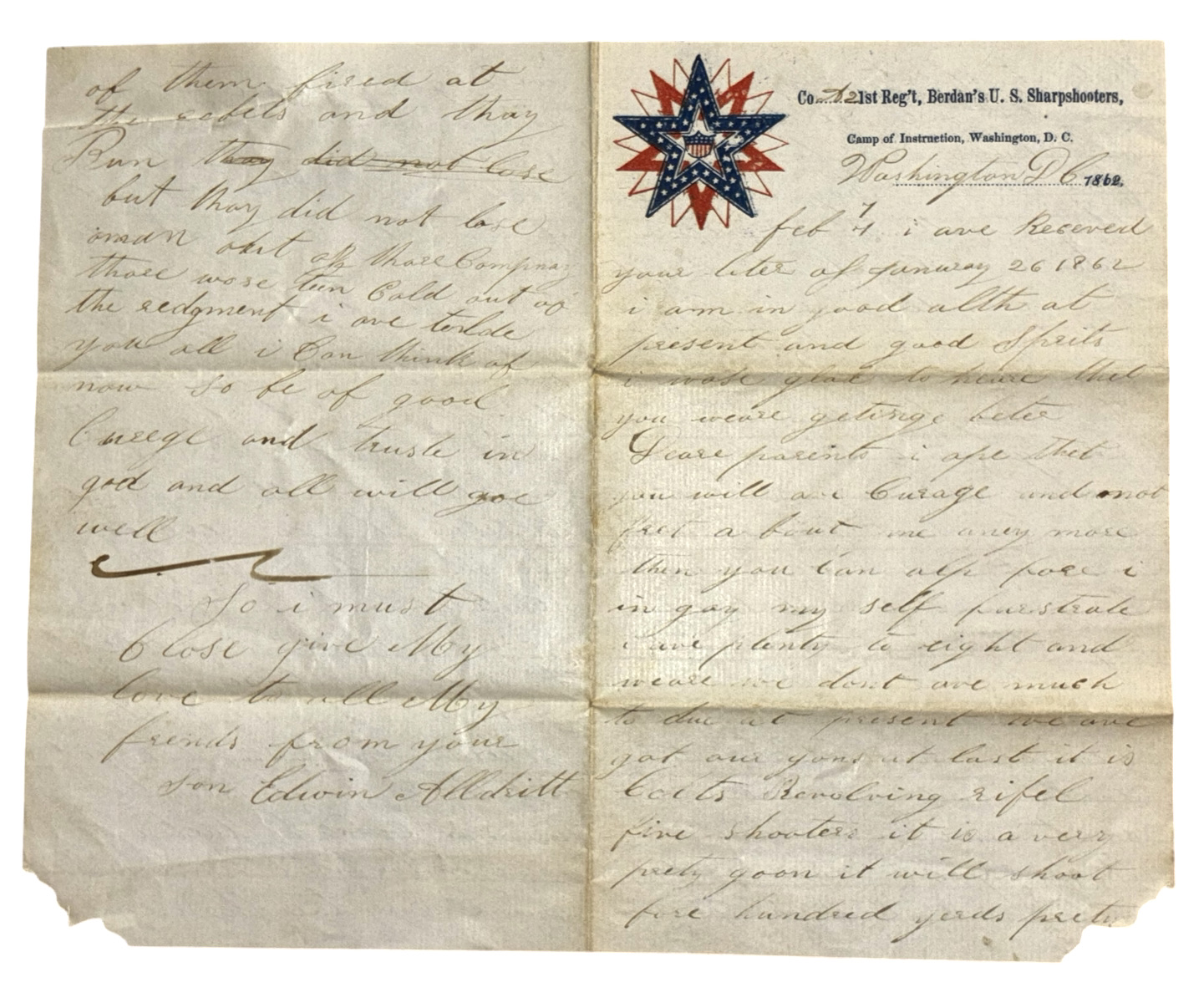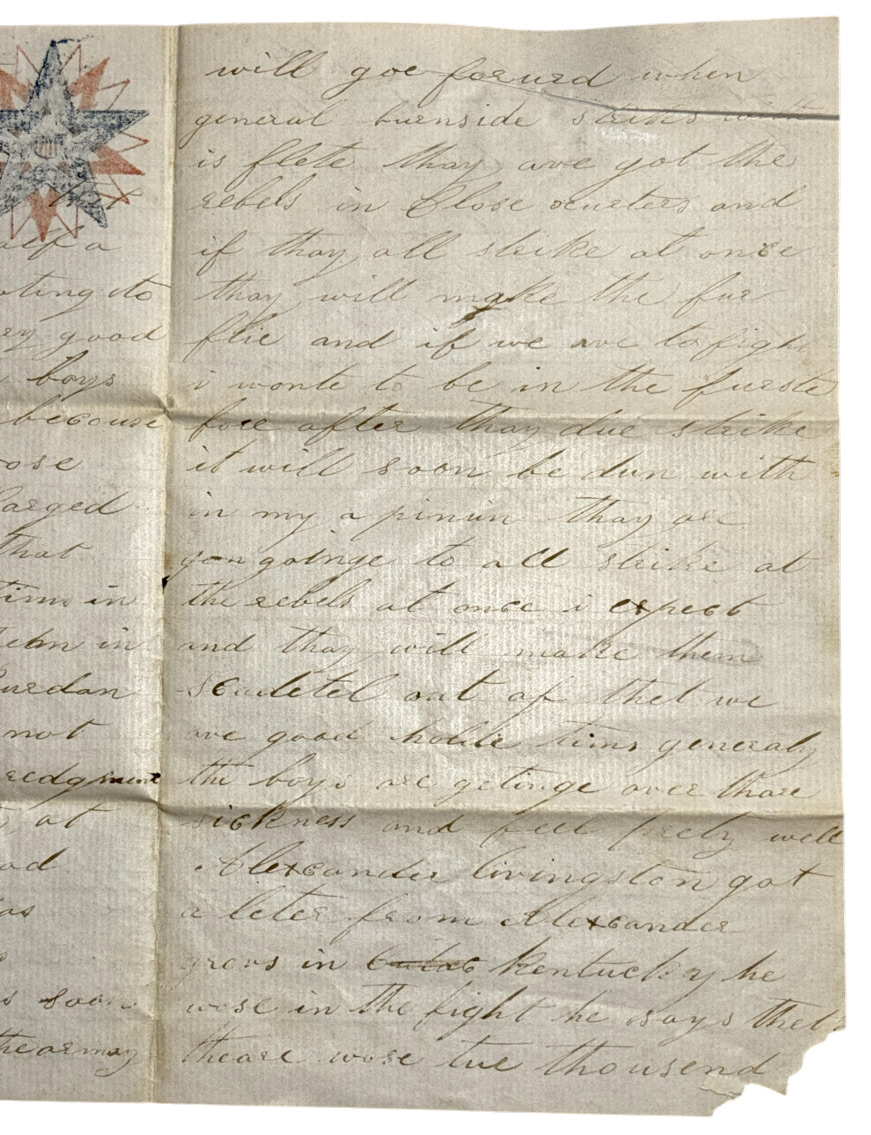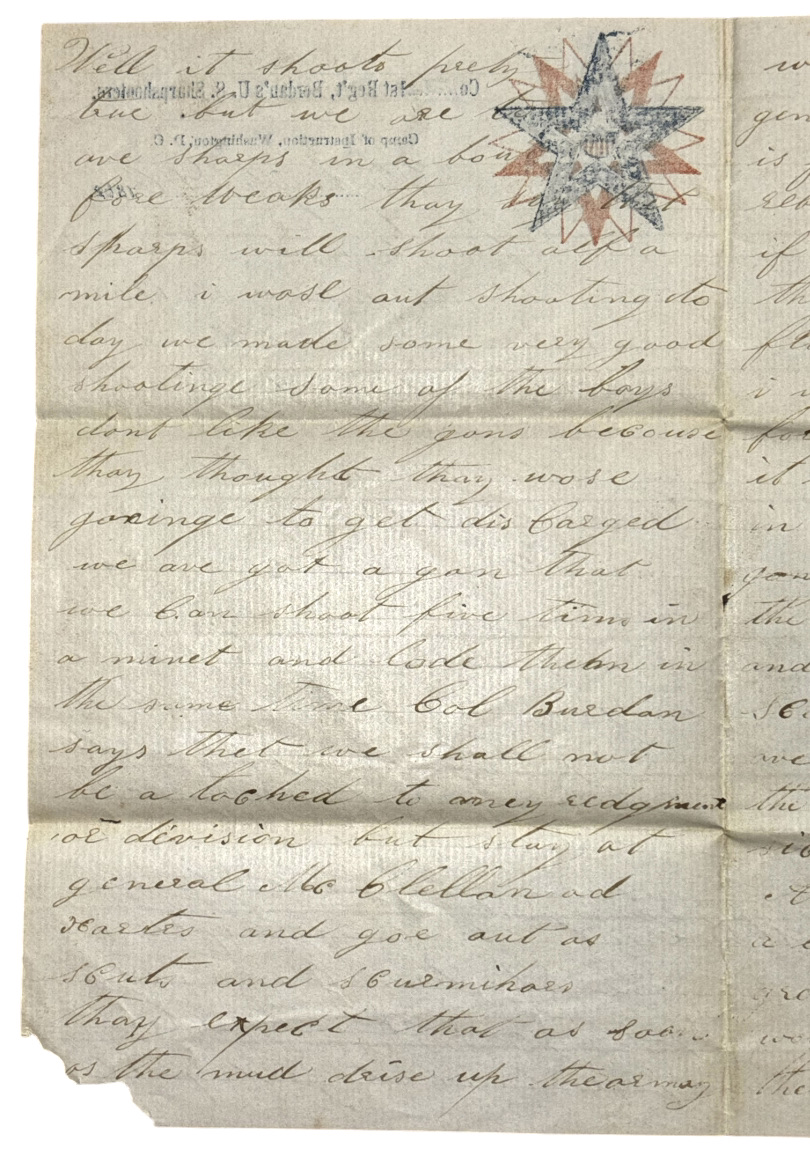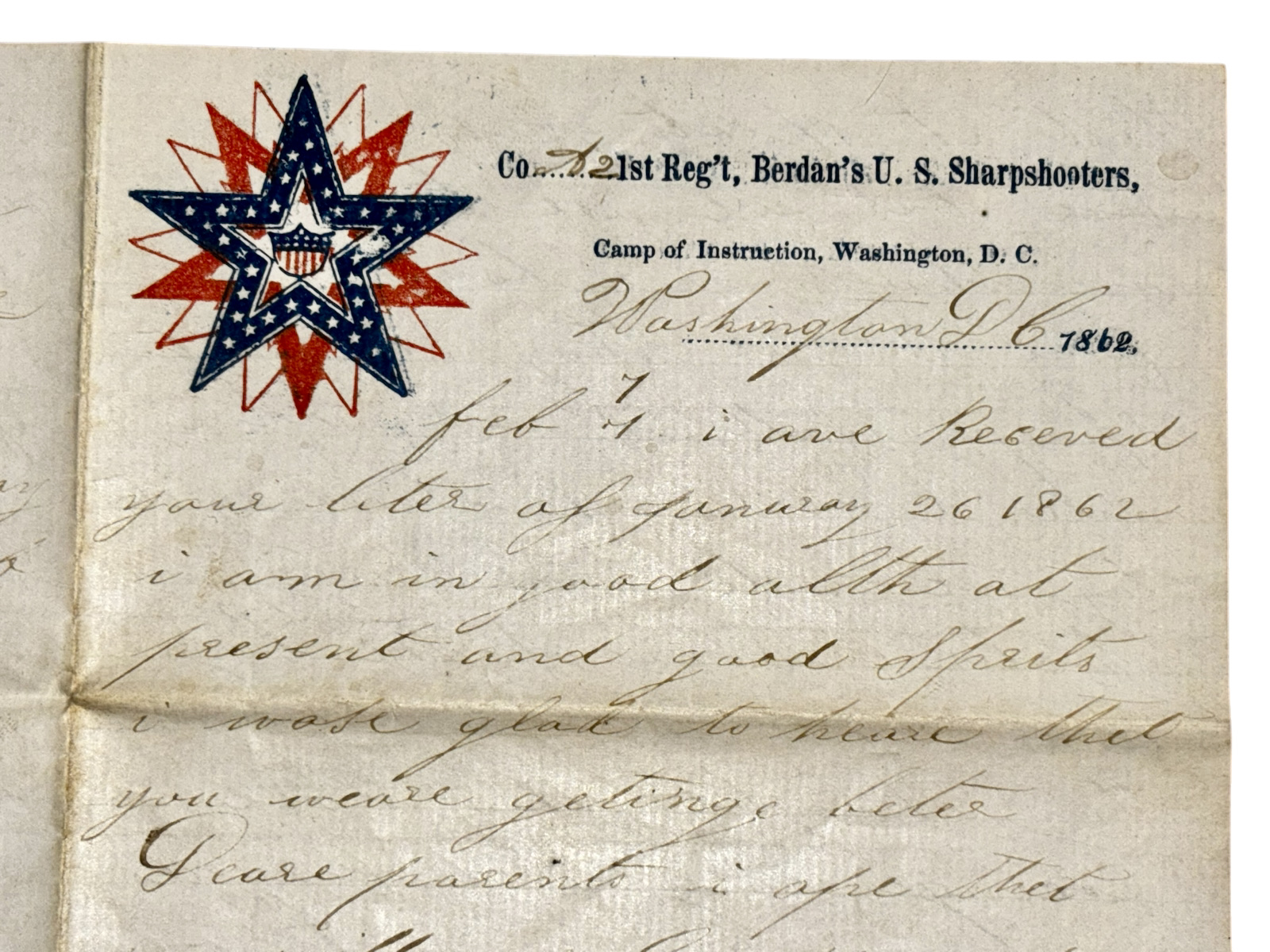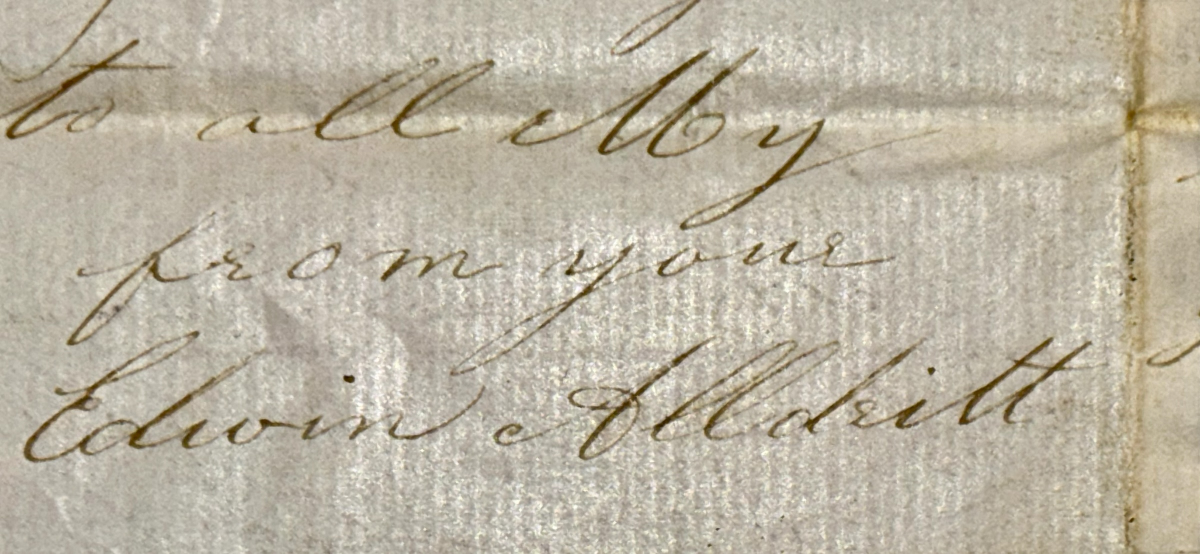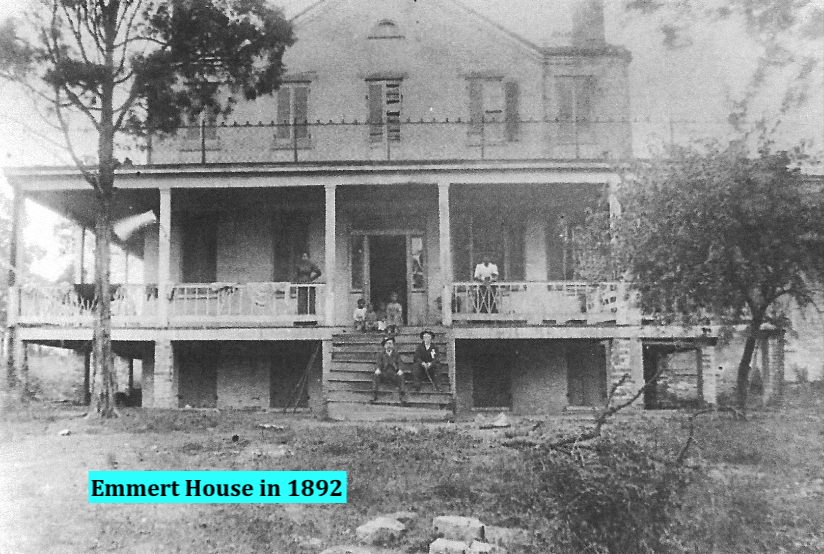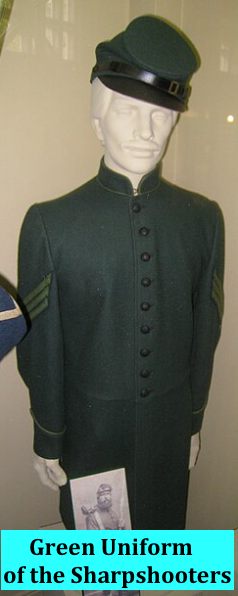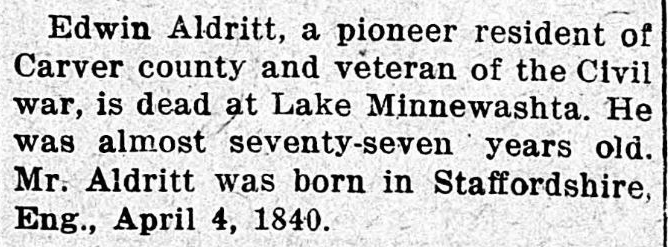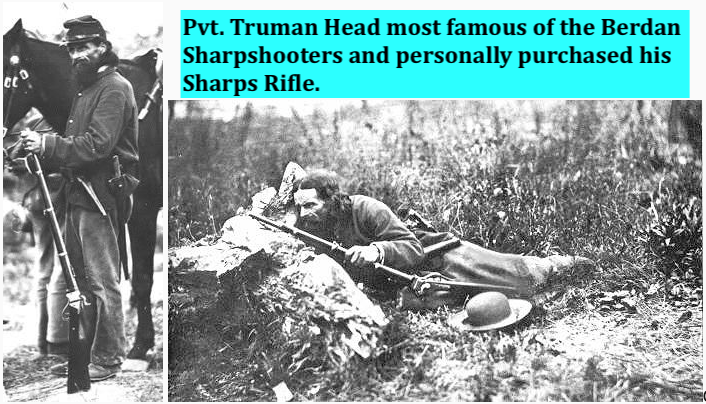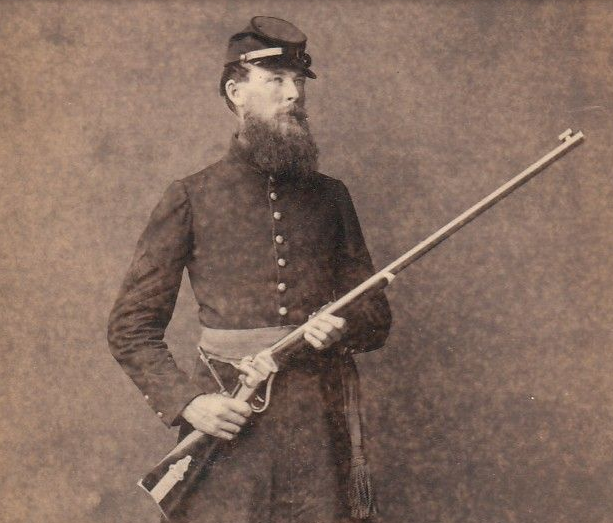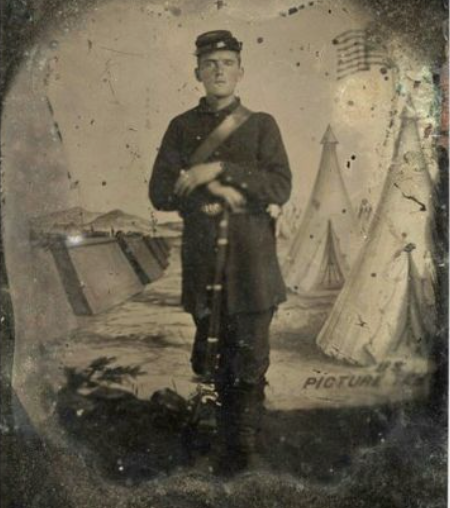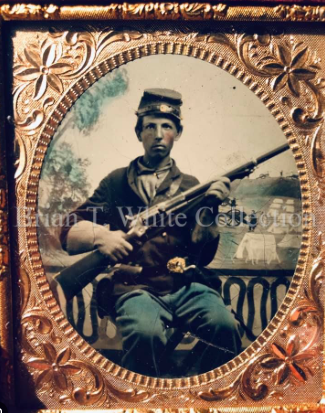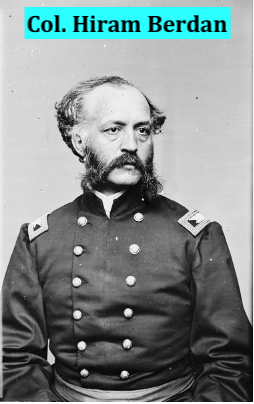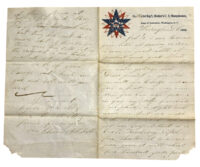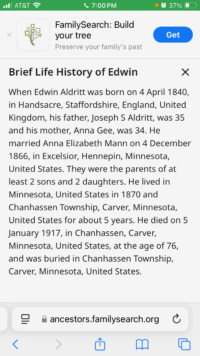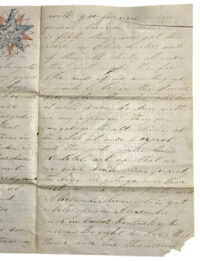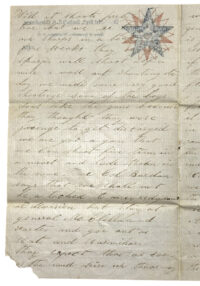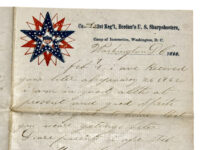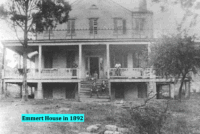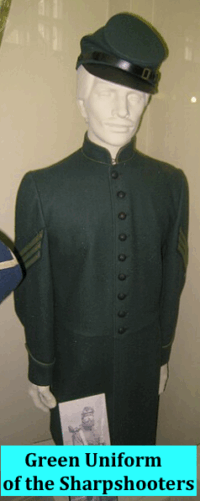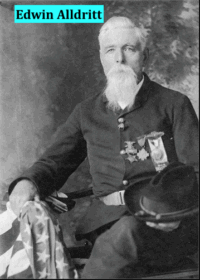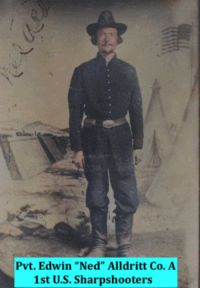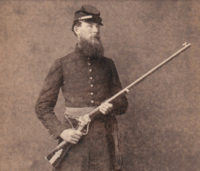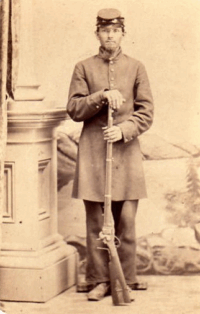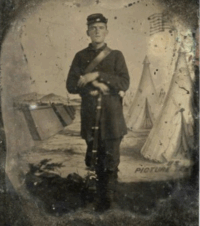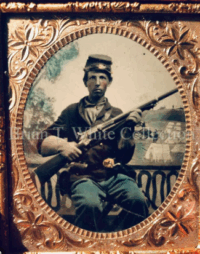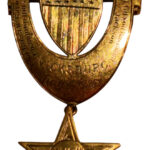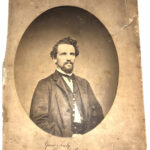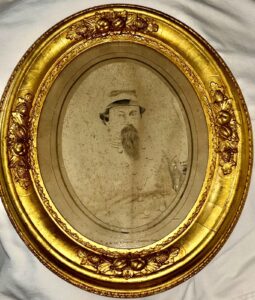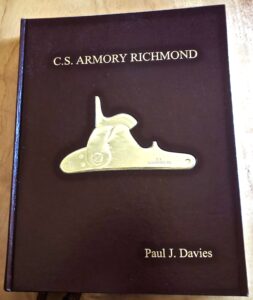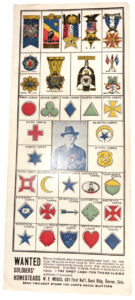Letter Written by a Member of Berdan’s Sharpshooters from Col. Berdan’s Camp of Instruction in 1862 – Letter Discusses Merits of the Colt Revolving Rifle vs. the Sharps Rifle
$675
Letter Written by a Member of Berdan’s Sharpshooters from Col. Berdan’s Camp of Instruction in 1862 – Letter Discusses Merits of the Colt Revolving Rifle vs. the Sharps Rifle – This is a somewhat lengthy letter written on patriotic stationery, by a soldier in Berdan’s Sharpshooters, from the so-called “Camp of Instruction” at Washington, DC, on February 7, 1862, to his parents. The letter, although written in ink and quite legible, is replete with grammatical, syntactical and spelling errors; it is most apparent that this young soldier had a very limited academic background. In the letter, Private Alldritt relates to parents that he is in good health and admonishes them not to be concerned; he mentions that his regiment of sharpshooters were initially provided with Colt revolving rifles and that these rifles can shoot five hundred yards, but that in five weeks, they will be getting the Sharps rifles that he mentions “can shoot half a mile”. He also mentions Colonel Berdan affirming that the Sharpshooters will not be attached to another regiment, but remain under Gen. McClellan. Additionally, Alldritt says that when Gen. Burnside arrives that the fighting will commence, and that the rebels will skedaddle; he says that the regiment will be employed, in the field, as scouts and skirmishers. Alldritt tells his parents that he has heard from a friend who is serving in the Kentucky area and has just participated in a significant battle.
This letter was written about three months after Alldritt enlisted; the rare, patriotic stationery with the Berdan Camp of Instruction imprint, indicates that Alldritt was training at the instructional camp as a member of the elite Berdan’s sharpshooters. Alldritt would remain with the Sharpshooters throughout the rest of the war, surviving a lengthy list of significant engagements to include the Battle of Williamsburg, the Seven Days’ Battles, the Battles of White Oak Swamp, Malvern Hill, Second Bull Run, South Mountain, Antietam, Fredericksburg, Chancellorsville, Gettysburg, Mine Run, Bristoe Station, the Wilderness, Spotsylvania, Cold Harbor and the Siege of Petersburg.
The letter remains in excellent condition, with a small area of the bottom right and left corners torn off, but not impacting the text of the body of the letter.
Transcription of the letter written by Private Edwin Alldritt, Co. A 1st / 2nd Berdan’s Sharpshooters:
Co. A 21st Reg’t, Berdan’s U.S. Sharpshooters,
Camp Instruction, Washington, D.C.
Washington, DD 1862.
Feb 7 i have receved (sic)
your leter (sic) of January 26 1862
i am in good alth (sic) at
present and in good sprits (sic)
i wase (sic) glad have …?
that you are getting (sic) beter (sic)
Dear parents I ope (sic) that
you will ave (sic) Curage (sic) and not
fret about me any more
then you can alp (sic) yorsel (sic)
in gay my self …?
I ave (sic) plenty to eight (sic) and
weare (sic) we dont (sic) ave much
to due (sic) at present we ave (sic)
got our gons (sic) at last it is
Colts Revolving rifel (sic)
five shooters it is a very
prety (sic) goon (sic) it will shoot
five hundred yards prety (sic)
(over)
Well it shoots prety (sic)
true but we all try to
ave (sic) Sharps in about
five weaks (sic) thay (sic) say
Sharps will shoot alf (sic) a
mile I wose (sic) out shooting it
day we made very
good shootinge (sic) some of the boys
dont (sic) like the gons (sic) because
they thought they wose (sic)
goinge (sic) to get discarged (sic)
we ave (sic) got a gon (sic) that
we can shoot five time in
a minet (sec) and lode (sic) them in
the same time Col Burdan (sic)
says thet (sic) we shall not
be a tached (sic) to any redgment (sic)
or division but stay at
general Mc Clellan (sic) ad (sic)
Hartes (sic ?) and goe (sic) as
SCotes (sic) and scarmihoes (sic)
thay (sic) expect that as soon
as the mud drise (sic) up the armay (sic)
(next page)
will go formed (?) when
general burnside …? with
his flete (sic) thay (sic) ave (sic) got the
rebels in close qrueters (sic) and
if thay (sic) strike at once
they will make the fire
flie (sic) and if we have to fight
it wonte (sic) to be in the furste (sic)
fire after thay (sic) do strike
it will soon be dun (sic) with
in my a piniun (sic) thay (sic) are
…? goinge (sic) to all strike at
the rebels at once i (sic) expect
and they will make them
scadetel (sic) out af? thet (sic) we
ave good holde (sic?) tims (sic) general
the boys are getinge (sic) over thare (sic)
sickness and feel reely (sic) well
Alexander Livingston got
a leter (sic) from Alexander
grens (sic ?) in Kentucky he
wose (sic) in the fight he says thet (sic)
theare (sic) wose (sic) tue (sic) thousand (sic)
(over)
of them fired at
the rebels and thay (sic)
Run (several words crossed out)
but they did not lose
a man out of three Compnay (sic)
thare (sic) ten cold (sic) out of
the redgment (sic) i ave (sic) tolde (sic)
you all i can think of
so be of good
Curege (sic) and truste (sic) in
god (sic) and all will goe (sic)
well
So i must
Close give My
love to all My
frends (sic) from your
son Edwin Alldritt
| Surname | Aldritt |
| Given Name and Rank | Edwin Pvt |
| Age | 21 |
| Induction Date | 05/Oct/1861 |
| Regiment | FIRST SHARPSHOOTERS |
| State of Residence | Minn |
| Notes | SERVICE; TRANSF. TO 1 BAT., MINN VOLS., 30/JAN/1865 |
| Discharge Date | JUL/1865 |
| Name | Edwin Aldritt |
| Enlistment Age | 21 |
| Birth Date | abt 1840 |
| Enlistment Date | 5 Oct 1861 |
| Enlistment Rank | Private |
| Muster Date | 5 Oct 1861 |
| Muster Company | A |
| Muster Regiment | U.S. Volunteers 2nd SS |
| Muster Regiment Type | Sharpshooters |
| Muster Information | Enlisted |
| Rank Change Rank | Corpl |
| Muster Out Date | 30 Jan 1865 |
| Muster Out Information | Transferred |
| Side of War | Union |
| Survived War? | Yes |
| Additional Notes 2 | Muster 2 Date: 30 Jan 1865; Muster 2 Place: Minnesota; Muster 2 Unit: 3385; Muster 2 Regiment: 1st Battn Vols; Muster 2 Regiment Type: Volunteers; Muster 2 Information: Transferred; Muster Out 2 Date: 15 Jul 1865; Muster Out 2 Information: Mustered Out |
| Name | Edwin Aldritt |
| Gender | Male |
| Birth Date | 4 Apr 1840 |
| Birth Place | Staffordshire, England |
| Death Date | 10 Jan 1917 |
| Death Place | Waconia, Carver County, Minnesota, United States of America |
| Cemetery | Woodside Cemetery |
| Burial or Cremation Place | Shorewood, Hennepin County, Minnesota, United States of America |
| Has Bio? | Y |
| Mother | Anna Aldritt |
| Spouse | Ann Elizabeth AldrittMaria Lizzie Aldritt |
| Children | Essie Idella MaynardJohn Edwin AldrittLizzie AldrittWilliam Joseph Aldritt |
The “21st Regiment Berdan’s Sharpshooters” refers to a regiment of sharpshooters, specifically the first two regiments of the United States Sharpshooters, led by Colonel Hiram Berdan during the American Civil War. These regiments were known for their superior marksmanship and were often used for special assignments, such as skirmish duty. The 21st Regiment designation is not accurate as it was actually the 1st and 2nd United States Sharpshooters.
Berdan’s Sharpshooters initially received Colt Model 1855 revolving rifles, but they were not satisfied and demanded the Sharps rifles they had been promised. The Sharpshooters used Colt revolving rifles briefly, particularly during the Siege of Yorktown, where they engaged in skirmishing and targeting enemy artillery; however, they were later replaced with the promised Sharps rifles.
1st United States Sharpshooters
| 1st United States Sharpshooters Regiment | |
| Founded | September 2, 1860 |
| Disbanded | December 31, 1864 |
| Country | United States (Union) |
| Type | Sharpshooter |
| Size | Regiment |
| Equipment | Sharps rifle |
| Engagements | American Civil War
· Battle of Hanover Court House · Second Battle of Rappahannock Station |
| Commanders | |
| Notable commanders |
Colonel Hiram Berdan |
The 1st United States Sharpshooters were an infantry regiment that served in the Union Army during the American Civil War. During battle, the mission of the sharpshooter was to kill enemy targets of importance (i.e., officers, NCOs, and artillery crews) from long range.
The first regiment of volunteers began service in late November 1860. During their service, they fought in every Eastern battle up until autumn of 1864. During their tour, the Sharpshooters were noted for efficient service in the battles of Yorktown, Gettysburg, Spotsylvania and Petersburg.
The 1st and 2nd U.S. Sharpshooters were consolidated on December 31, 1864.
Founder
Hiram C. Berdan was the founder of the Sharpshooters. Berdan was born in the town of Phelps, New York, on September 6, 1824. Not only was Berdan a military officer in the Civil War and creator of the Sharpshooters regiment, he was also an American mechanical engineer and creative inventor. Some of Berdan’s inventions included the Berdan rifle (a repeating rifle) and the Berdan center fire primer, a range finder torpedo boat for evading torpedo nets during and after the Civil War. Berdan also developed the first commercial gold amalgamation machine to separate gold from ore. Berdan was also known for being an amateur champion marksman in the United States. Berdan’s interest in rifles and shooting led him to the idea of creating a regiment full of men who all had notable shooting skills: the Sharpshooters. Berdan left active service in the field in the summer of 1863. He died on March 31, 1893, and was buried in the Arlington National Cemetery.
Raising the regiment
During the Civil War, regiments were usually composed of companies all from the same state. On the other hand, due to the strict qualifications and special skills in order to become a member of the Sharpshooters, each regiment was assembled of companies from various different Union states. Below is a list of each company in the first regiment, their origin and date of establishment.
- Companies “A, B, C, D, E, F, G, H, I, K”
- Companies “A”, “D” and “H” were organized at New York City, New Yorkin September 1860.
- Company “B” was organized at Albany, New Yorkin September 1860.
- Company “C” in Michiganon August 21, 1860.
- Company “E” in New Hampshireon September 9, 1861.
- Company “F” in Vermonton September 13, 1861
- Company “G”in Wisconsin on September 23, 1861.
- Company “I” in Michiganon March 4, 1862.
- Company “K” in Michiganon March 30, 1862.
Company commanders
The first United States Sharpshooter regiment consisted of the following commanding officers (listed by company):
- Company A- Captain Casper Trepp, New York
- Company B- Captain Stephen Martin, New York
- Company C- Captain Benjamin Duesler, Michigan
- Company D- Captain George S. Tuckerman, New York
- Company E- Captain Amos B. Jones, New Hampshire
- Company F- Captain Edmund Weston, Vermont
- Company G– Captain Edward Drew, Wisconsin
- Company H- Captain George G. Hastings, New York
- Company I- Captain A. M. Willet, Michigan
- Company K- Captain S. J. Mather, Michigan
Selection of recruits
Hiram C. Berdan began recruiting men for the first Sharpshooter regiment in 1861. He recruited men from New York City and Albany and from the states of New Hampshire, Vermont, Michigan and Wisconsin.
The volunteer recruits had to pass a marksmanship test in order to qualify to be a member of the Sharpshooters; each man had to be able to place ten shots in a circle of 10 inches (250 mm) in diameter from 200 yards (180 m) away. The shots were to be accurate enough so that the average distance of them all would be 5 inches (127 mm) or less from the center of the target. They used a piece of string to measure from the center point to each bullet hole. The accumulated distance for all the shots on this string could measure no more than 50 inches (127 cm) long. They were allowed to choose a rifle and position of their preference for the test. A man eligible to be a Sharpshooter had to possess a keen eye, steady hands and a great deal of training and skill with a rifle. In addition to that, for a man to be a Sharpshooter, it took cool nerves in order to be able to estimate their target carefully, determine the high trajectory needed and to take in consideration the effect that any current wind may have.
Weapons
The men of the Sharpshooters regiment were armed with various types of rifles, including the Sharps rifle, the Whitworth rifle, sporting arms, and various other custom-made privately owned target weapons. Some of these rifles weighed up to 30 pounds (14 kg) because they contained the first breed of telescope sights.[citation needed] At first, many of the Sharpshooter riflemen used their own weapons, but this led to problems when it came to ammunition supply. As a result, Berdan made a request to receive issuance of Sharps rifles to his men.
Christian Sharps invented the Sharps rifle in 1848 in Hartford, Connecticut. It was a single shot percussion lock breech loader that could be fired eight to ten times per minute (three times the rate of the Springfield rifle), weighed about 12 pounds (5.4 kg), was 47 inches (1,200 mm) in length with a 30-inch (760 mm) barrel and fired cartridges with a .52 caliber conical ball. The Sharps rifle was accurate up to 600 yards (550 m), so the typical Sharpshooter was able to put twenty bullets in a 24-inch (610 mm) pattern from 200 yards (180 m) away. The first Sharps rifle in the regiment was purchased by Private Truman “California Joe” Head while the regiment was at the camp of instruction outside Washington, D.C. during the winter of 1861–1862.
Berdan chose the Sharps rifle mainly because of its fast breech loading and outstanding accuracy from long-range distances. Lieutenant General Winfield Scott denied Berdan’s request because he feared the issuance of Sharps rifles would lead to a waste of ammunition. Lt. General Scott insisted that Berdan’s men use a standard Springfield rifle. Berdan was not at all satisfied with Scott’s ruling, so he took his request for Sharps rifles directly to President Abraham Lincoln. After Lincoln watched Berdan perform a demonstration of the Sharps rifle’s extreme speed and accuracy he was so impressed that he ordered them to be immediately issued to both Sharpshooter regiments. Nevertheless, many of the men still continued to use their own rifles, no matter how heavy and bulky they were, probably because that is what they had training and experience with. The sharpshooters were finally issued their Sharps rifles on May 8, 1862.
Uniform
The green uniform of the sharpshooters
The most notable aspect of the Berdan Sharpshooter uniform is the green color, rather than the standard Union blue. They were one of only a few regiments that went outside the typical Potomac Army’s uniform. The green uniform gave the sharpshooters the clear advantage of camouflage, but also sometimes was a disadvantage because they were easy to distinguish against the rest of the Union soldiers for Confederate marksmen to spot and target. Sharpshooters were high-priority kills amongst the Confederate army, because they had such high skills and good salvageable equipment. Sharpshooters used more guerrilla warfare battle tactics than the rest of the Union infantry. Along with the green uniform, a soldier was to have no brass on any of their buttons. Their shoes were standard Union issue, but their pants were made of green wool just like the frock coats, with a pair of gaiters. Furthermore, Sharpshooter knapsacks were a Prussian-style fur sack fitted over a wooden frame, as opposed to the usual tarred canvas. However, as the war went on the men were not reissued this clothing and many of the men received standard federal clothing making it harder for rebel troops to notice their elite capabilities. By the Gettysburg campaign most of the men were wearing modified blue uniforms.
Total strength and casualties
Ten of the regiment’s officers and 143 enlisted men were killed in action or mortally wounded and 1 officer and 128 enlisted men died of disease, for a total of 282 deaths in the service.
Lieutenant Colonel William Y. W. Ripley was wounded and later received the Medal of Honor for his heroism as second in command of the 1st U.S. Sharpshooters at the Battle of Malvern Hill.
The picture below is a piece of the 1st U.S. Sharpshooters stationary that was used on a letter home by Charles W. Seaton of Co. F, 1st USSS (the same unit as Jerome Fountain). Charles marked his tent location, and the 2nd USSS camp was used on the back of the envelope. Both the stationary and envelope had the Rosenthal scenes.
Jerome’s commanding officers were in the tent marked 12, along with the Michigan Company C. The other two Michigan companies had not arrived yet in Oct./Nov. 1861 when the scene was sketched. As Seaton described, Jerome’s company street would be in line with tent 12.
The house visible just behind the 2nd’s Camp was identified in his journal as belonging to William Emmert by George A. Marden of Co. G, 2nd USSS. Emmert is described as the owner of this house.
The house seen on the picture (Rosenthal Lithograph) was built of brick and was occupied by Mr. Emmert, “a German, with a small family and Col. Berdan and suite comprising his modest Privite Sec’y., alias 3rd Serg’t., Co. G, and a splendid dog “Sport.” “Mr. Emmert is a dirty looking Dutchman built, I imagine, like the renowned Wouter Van Twiller as described by Irving. He has a very husky voice and when he comes in to complain about the destruction of his property by the boys, grows pathetic and weeps. He is certainly a martyr for the Union.”
Additionally, in William Emmert’s property damage claim, he says, “the United States Sharpshooters were camped on his property.”
During the GAR Reunion in Washington, DC in 1892, two Co.A, 2nd USSS Sharpshooters visited the Camp of Instruction area and were photographed at the Emmert house.

